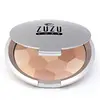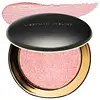What's inside
What's inside
 Key Ingredients
Key Ingredients

 Benefits
Benefits

 Concerns
Concerns

 Ingredients Side-by-side
Ingredients Side-by-side

Mica
Cosmetic ColorantCetyl Palmitate
EmollientEthylhexyl Palmitate
EmollientSilica
AbrasiveKaolin
AbrasivePersea Gratissima Fruit Extract
EmollientZinc Stearate
Cosmetic ColorantSimmondsia Chinensis Seed Oil
EmollientCaprylic/Capric Triglyceride
MaskingLecithin
EmollientCrithmum Maritimum Extract
Skin ConditioningTocopheryl Acetate
AntioxidantIron Oxides
Titanium Dioxide
Cosmetic ColorantCaprylic/Capric Triglyceride
MaskingOctyldodecanol
EmollientMica
Cosmetic ColorantSimmondsia Chinensis Seed Oil
EmollientSilica
AbrasiveCera Alba
EmollientHelianthus Annuus Seed Wax
Skin ConditioningCalcium Sodium Borosilicate
Aroma
Octyldodecyl Myristate
EmollientCapparis Spinosa Fruit Extract
Skin ConditioningEthylhexyl Palmitate
EmollientDimethylmethoxy Chromanol
AntioxidantTrihydroxystearin
Skin ConditioningSodium Hyaluronate
HumectantTin Oxide
AbrasiveCI 77891
Cosmetic ColorantIron Oxides
CI 75470
Cosmetic ColorantCaprylic/Capric Triglyceride, Octyldodecanol, Mica, Simmondsia Chinensis Seed Oil, Silica, Cera Alba, Helianthus Annuus Seed Wax, Calcium Sodium Borosilicate, Aroma, Octyldodecyl Myristate, Capparis Spinosa Fruit Extract, Ethylhexyl Palmitate, Dimethylmethoxy Chromanol, Trihydroxystearin, Sodium Hyaluronate, Tin Oxide, CI 77891, Iron Oxides, CI 75470
Ingredients Explained
These ingredients are found in both products.
Ingredients higher up in an ingredient list are typically present in a larger amount.
This ingredient is an emollient, solvent, and texture enhancer. It is considered a skin-softener by helping the skin prevent moisture loss.
It helps thicken a product's formula and makes it easier to spread by dissolving clumping compounds.
Caprylic Triglyceride is made by combining glycerin with coconut oil, forming a clear liquid.
While there is an assumption Caprylic Triglyceride can clog pores due to it being derived from coconut oil, there is no research supporting this.
Learn more about Caprylic/Capric TriglycerideEthylhexyl Palmitate, also known as octyl palmitate, is created from 2-ethylhexyl alcohol and palmitic acid. It is a fatty acid ester.
The fatty acid content of Ethylhexyl Palmitate makes it an emollient. Emollients help soften and hydrate your skin by trapping moisture within.
Ethylhexyl Palmitate is also used to help improve the texture of cosmetics. It helps other ingredient dissolve in products and help disperse ingredients more evenly.
You'll likely find this ingredient in sunscreen, as it is often used to mix UV-blocking ingredients such as avobenzone and ethylhexyl triazone.
It can also help stabilize the fragrances in a product as a fragrance fixative.
Ethylhexyl Palmitate can be used to substitute mineral oil.
Due to its high fatty acid content, it may not be fungal-acne safe.
Learn more about Ethylhexyl PalmitateMica is a naturally occurring mineral used to add shimmer and color in cosmetics. It can also help improve the texture of a product or give it an opaque, white/silver color.
Serecite is the name for very fine but ragged grains of mica.
This ingredient is often coated with metal oxides like titanium dioxide. Trace amounts of heavy metals may be found in mica, but these metals are not harmful in our personal products.
Mica has been used since prehistoric times throughout the world. Ancient Egyptian, Indian, Greek, Roman, Aztec, and Chinese civilizations have used mica.
Learn more about MicaSilica, also known as silicon dioxide, is a naturally occurring mineral. It is used as a fine, spherical, and porous powder in cosmetics.
Though it has exfoliant properties, the function of silica varies depending on the product.
The unique structure of silica enhances the spreadability and adds smoothness, making it a great texture enhancer.
It is also used as an active carrier, emulsifier, and mattifier due to its ability to absorb excess oil.
In some products, tiny microneedles called spicules are made from silica or hydrolyzed sponge. When you rub them in, they lightly polish away dead skin layers and enhance the penetration of active ingredients.
Learn more about SilicaThis oil comes from the seeds of the desert shrub called Jojoba. It is more commonly known as jojoba oil, a non-comedogenic oil.
Jojoba oil does not contain fragrance and has many fatty-acids, making it a great soothing ingredient.
It also contains Vitamin E, a great moisturizing ingredient. Vitamin E is also an antioxidant and protects your skin against oxidative damage.
This ingredient humectant properties, meaning it helps draw moisture from the air. This helps keep your skin hydrated.
While jojoba has antibacterial properties, it is only able to kill some strains of bacteria.
Studies also show it helps in wound healing. In fact, Indigenous cultures have used jojoba as a moisturizer and to help treat burns for centuries.
Fun fact: Jojoba oil similar to natural human skin sebum, so it has a great effect on dry skin. It is also promising with helping to regulate sebum production.
Due to its fatty acid content, Jojoba oil may not be fungal acne safe. We recommend speaking with a professional if you have any concerns.
Learn more about Simmondsia Chinensis Seed OilThis ingredient is a combination of red, black, and yellow iron oxide pigments. This combination of colors is usually found in foundation, because it results in a "skin" color.